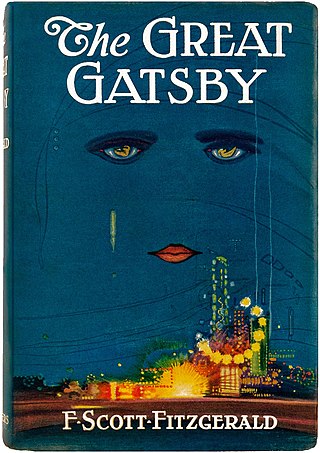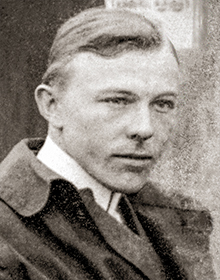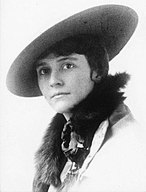
The Great Gatsby is a 1925 novel by American writer F. Scott Fitzgerald. Set in the Jazz Age on Long Island, near New York City, the novel depicts first-person narrator Nick Carraway's interactions with mysterious millionaire Jay Gatsby and Gatsby's obsession to reunite with his former lover, Daisy Buchanan.

Zelda Fitzgerald was an American novelist, painter, playwright, and socialite. Born in Montgomery, Alabama to a wealthy Southern family, she became locally famous for her beauty and high spirits. In 1920, she married writer F. Scott Fitzgerald after the popular success of his debut novel, This Side of Paradise. The novel catapulted the young couple into the public eye, and she became known in the national press as the first American flapper. Due to their wild antics and incessant partying, she and her husband became regarded in the newspapers as the enfants terribles of the Jazz Age. Alleged infidelity and bitter recriminations soon undermined their marriage. After traveling abroad to Europe, Zelda's mental health deteriorated, and she had suicidal and homicidal tendencies which required psychiatric care. Her doctors diagnosed Zelda with schizophrenia, although later posthumous diagnoses posit bipolar disorder.
Matthew Joseph Bruccoli was an American professor of English at the University of South Carolina. He was the preeminent expert on F. Scott Fitzgerald. He also wrote about other writers, notably Ernest Hemingway, Thomas Wolfe and John O'Hara, and was editor of the Dictionary of Literary Biography.

This Side of Paradise is the debut novel by American writer F. Scott Fitzgerald, published in 1920. It examines the lives and morality of carefree American youth at the dawn of the Jazz Age. Its protagonist, Amory Blaine, is an attractive middle-class student at Princeton University who dabbles in literature and engages in a series of romances with flappers. The novel explores the theme of love warped by greed and status-seeking, and takes its title from a line of Rupert Brooke's poem Tiare Tahiti.

Tender Is the Night is the fourth and final novel completed by American writer F. Scott Fitzgerald. Set in French Riviera during the twilight of the Jazz Age, the 1934 novel chronicles the rise and fall of Dick Diver, a promising young psychiatrist, and his wife, Nicole, who is one of his patients. The story mirrors events in the lives of the author and his wife Zelda Fitzgerald as Dick starts his descent into alcoholism and Nicole descends into mental illness.

A Lost Lady is a 1923 novel by American writer Willa Cather. It tells the story of Marian Forrester and her husband, Captain Daniel Forrester, who live in the Western town of Sweet Water along the Transcontinental Railroad. Throughout the story, Marian—a wealthy married socialite—is pursued by a variety of suitors and her social decline mirrors the end of the American frontier. The work had a significant influence on F. Scott Fitzgerald's 1925 novel, The Great Gatsby.

The Short Stories of F. Scott Fitzgerald is a compilation of 43 short stories by F. Scott Fitzgerald. It was edited by Matthew J. Bruccoli and published by Charles Scribner's Sons in 1989. It begins with a foreword by Charles Scribner II and a preface written by Bruccoli, after which the stories follow in chronological order of publication.

"Head and Shoulders" is a short story by F. Scott Fitzgerald. It was his first story to be published in the Saturday Evening Post, with the help of Fitzgerald's agent, Harold Ober. The story appeared in the February 21, 1920 issue and was illustrated by Charles D. Mitchell. It later appeared in his short story collection Flappers and Philosophers.

Jay Gatsby is the titular fictional character of F. Scott Fitzgerald's 1925 novel The Great Gatsby. The character is an enigmatic nouveau riche millionaire who lives in a luxurious mansion on Long Island where he often hosts extravagant parties and who allegedly gained his vast fortune by illicit bootlegging during prohibition in the United States. Fitzgerald based many details about the fictional character on Max Gerlach, a mysterious neighbor and World War I veteran whom the author met while living in New York City during the raucous Jazz Age. Like Gatsby, Gerlach threw lavish parties, never wore the same shirt twice, used the phrase "old sport", claimed to be educated at Oxford University, and fostered myths about himself, including that he was a relation of the German Kaiser.

The Great Gatsby is a 2000 British-American romantic drama television film, based on the 1925 novel of the same name by F. Scott Fitzgerald. It was directed by Robert Markowitz, written by John J. McLaughlin, and stars Toby Stephens in the title role of Jay Gatsby, Mira Sorvino as Daisy Buchanan, Paul Rudd as Nick Carraway, Martin Donovan as Tom Buchanan, Francie Swift as Jordan Baker, Heather Goldenhersh as Myrtle Wilson, and Matt Malloy as Klipspringer. The film aired on March 29, 2000 in the United Kingdom on BBC, and on January 14, 2001 in the United States on A&E.

"The Ice Palace" is a modernist short story written by F. Scott Fitzgerald and published in The Saturday Evening Post on May 22, 1920. It is one of eight short stories originally published in Fitzgerald's first collection, Flappers and Philosophers, and is also included in the collection Babylon Revisited and Other Stories.

Daisy Fay Buchanan is a fictional character in F. Scott Fitzgerald's 1925 novel The Great Gatsby. The character is a wealthy socialite from Louisville, Kentucky who resides in the fashionable town of East Egg on Long Island during the Jazz Age. She is narrator Nick Carraway's second cousin, once removed, and the wife of polo player Tom Buchanan, by whom she has a daughter. Before marrying Tom, Daisy had a romantic relationship with Jay Gatsby. Her choice between Gatsby and Tom is one of the novel's central conflicts. Described by Fitzgerald as a "golden girl", she is the target of both Tom's callous domination and Gatsby's dehumanizing adoration. The ensuing contest of wills between Tom and Gatsby reduces Daisy to a trophy wife whose sole existence is to augment her possessor's socio-economic success.

Francis Scott Key Fitzgerald was an American novelist, essayist, and short story writer. He is best known for his novels depicting the flamboyance and excess of the Jazz Age—a term he popularized in his short story collection Tales of the Jazz Age. During his lifetime, he published four novels, four story collections, and 164 short stories. Although he achieved temporary popular success and fortune in the 1920s, Fitzgerald received critical acclaim only after his death and is now widely regarded as one of the greatest American writers of the 20th century.

Ginevra King Pirie was an American socialite and heiress. As one of Chicago's "Big Four" debutantes during World War I, she inspired many characters in the novels and stories of writer F. Scott Fitzgerald; in particular, the character of Daisy Buchanan in The Great Gatsby. A 16-year-old King met an 18-year-old Fitzgerald at a sledding party in St. Paul, Minnesota, and they shared a passionate romance from 1915 to 1917.

All the Sad Young Men is the third collection of short stories written by F. Scott Fitzgerald, published by Scribners in February 1926.

Edith Cummings Munson, popularly known as The Fairway Flapper, was an American socialite and one of the premier amateur golfers during the Jazz Age. She was one of the Big Four debutantes in Chicago during World War I. She attained fame in the United States following her 1923 victory in the U.S. Women's Amateur. On August 25, 1924, she became the first golfer and first female athlete to appear on the cover of Time magazine. She also was the literary model for the character of Jordan Baker in F. Scott Fitzgerald's novel The Great Gatsby.

"The Rich Boy" is a short story by American writer F. Scott Fitzgerald. It was included in his 1926 collection All the Sad Young Men. "The Rich Boy" originally appeared in two parts, in the January and February 1926 issues of Redbook. In the January installment, the story is described on the front cover as: "A great story of today's youth by F. Scott Fitzgerald".
"Absolution" is a short story by American writer F. Scott Fitzgerald. It was included in his 1926 collection All the Sad Young Men.
"The Adjuster" is a short story written by American author F. Scott Fitzgerald. The story appears in Fitzgerald's third collection of short stories All the Sad Young Men, published by Scribners in February 1926. The story depicts the troubled relationship of married couple Luella and Charles Hemple, living in New York City in 1925.

Max von Gerlach was an acquaintance of American writer F. Scott Fitzgerald in New York. Gerlach was an officer in the American Expeditionary Forces during World War I who became a gentleman bootlegger and lived like a millionaire in New York. Flaunting his wealth as a bootlegger, Gerlach threw lavish parties, never wore the same shirt twice, used the phrase "old sport", claimed to be educated at Oxford University, and fostered myths about himself; including that he was a relation of the German Kaiser. These details about Gerlach inspired Fitzgerald in his creation of Jay Gatsby, the titular character of The Great Gatsby.




















